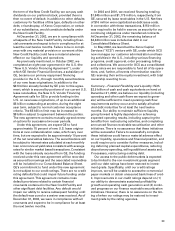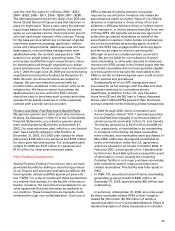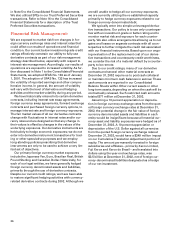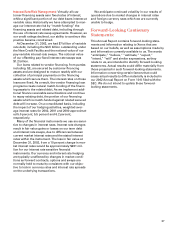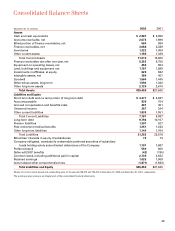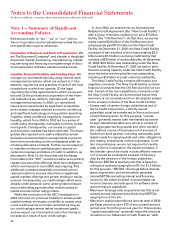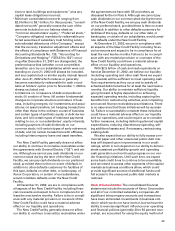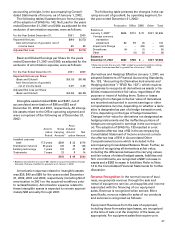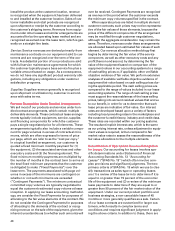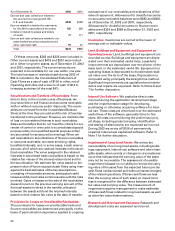Xerox 2002 Annual Report Download - page 44
Download and view the complete annual report
Please find page 44 of the 2002 Xerox annual report below. You can navigate through the pages in the report by either clicking on the pages listed below, or by using the keyword search tool below to find specific information within the annual report.
42
Note 1 — Summary of Significant
Accounting Policies
References herein to “we,” “us” or “our” refer to
Xerox Corporation and its subsidiaries unless the con-
text specifically requires otherwise.
Description of Business and Basis of Presentation: We
are The Document Company®, and a leader in the global
document market, developing, manufacturing, market-
ing, servicing and financing a complete range of docu-
ment equipment, software, solutions and services.
Liquidity, Financial Flexibility and Funding Plans: We
manage our worldwide liquidity using internal cash
management practices, which are subject to (1) the
statutes, regulations and practices of each of the local
jurisdictions in which we operate, (2) the legal
requirements of the agreements to which we are par-
ties and (3) the policies and cooperation of the finan-
cial institutions we utilize to maintain such cash
management practices. In 2000, our operational
issues were exacerbated by significant competitive
and industry changes, adverse economic conditions,
and significant technology and acquisition spending.
Together, these conditions negatively impacted our
liquidity, which from 2000 to 2002 led to a series of
credit rating downgrades, eventually to below invest-
ment grade. Consequently, our access to capital
and derivative markets has been restricted. The down-
grades also required us to cash-collateralize certain
derivative and securitization arrangements to prevent
them from terminating, and to immediately settle ter-
minating derivative contracts. Further, we are required
to maintain minimum cash balances in escrow on
certain borrowings and letters of credit. In addition, as
discussed in Note 15, the Securities and Exchange
Commission (the “SEC”) would not allow us to publicly
register any securities offerings while its investigation,
which commenced in June 2000, was ongoing. This
additional constraint essentially prevented us from
raising funds from sources other than unregistered
capital markets offerings and private lending or equity
sources. Consequently, our credit ratings, which were
already under pressure, came under greater pressure
since credit rating agencies often include access to
capital sources in their rating criteria.
While the conclusion of the SEC investigation in
2002 removed our previous inability to access public
capital markets, we expect our ability to access unse-
cured credit sources to remain restricted as long as
our credit ratings remain below investment grade,
and we expect our incremental cost of borrowing to
increase as a result of such credit ratings.
In June 2002, we entered into an Amended and
Restated Credit Agreement (the “New Credit Facility”)
with a group of lenders, replacing our prior $7 billion
facility (the “Old Revolver”). At that time, we perma-
nently repaid $2.8 billion of the Old Revolver and
subsequently paid $710 million on the New Credit
Facility. At December 31, 2002, the New Credit Facility
consisted of two tranches of term loans totaling $2.0
billion and a $1.5 billion revolving credit facility that
includes a $200 letter of credit subfacility. At December
31, 2002, $3.5 billion was outstanding under the New
Credit Facility. At December 31, 2002 we had no addi-
tional borrowing capacity under the New Credit Facility
since the entire revolving facility was outstanding,
including a $10 letter of credit under the subfacility.
The New Credit Facility contains affirmative and
negative covenants. The New Credit Facility contains
financial covenants that the Old Revolver did not con-
tain. Certain of the more significant covenants under
the New Credit Facility are summarized below (this
summary is not complete and is in all respects subject
to the actual provisions of the New Credit Facility):
• Excess cash of certain foreign subsidiaries and of
Xerox Credit Corporation, a wholly-owned
subsidiary, must be transferred to Xerox at the end
of each fiscal quarter; for this purpose, “excess
cash” generally means cash maintained by certain
foreign subsidiaries taken as a whole in excess of
their aggregate working capital and other needs in
the ordinary course of business (net of sources of
funds from third parties), including reasonably antic-
ipated needs for repaying debt and other obligations
and making investments in their businesses. In cer-
tain circumstances, we are not required to transfer
cash to Xerox Corporation, the parent company, if
the transfer cannot be made in a tax efficient manner
or if it would be considered a breach of fiduciary
duty by the directors of the foreign subsidiary;
• Minimum EBITDA (a quarterly test that is based on
rolling four quarters) ranging from $1.0 to $1.3 billion;
for this purpose, “EBITDA” (Earnings before interest,
taxes, depreciation and amortization) generally
means EBITDA (excluding interest and financing
income to the extent included in consolidated net
income), less any amounts spent for software devel-
opment that are capitalized;
• Maximum leverage ratio (a quarterly test that is cal-
culated as total adjusted debt divided by EBITDA)
ranging from 4.3 to 6.0;
• Maximum capital expenditures (annual test) of $330
per fiscal year plus up to $75 of any unused amount
carried over from the previous year; for this purpose,
“capital expenditures” generally mean the amounts
included on our Statement of Cash Flows as “addi-
Notes to the Consolidated Financial Statements
(Dollars in millions, except per-share data and unless otherwise indicated)



